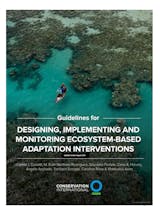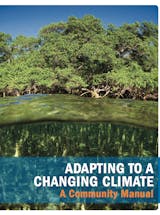Clinging to coastlines in the tropics, mangrove forests cover a tiny fraction of the planet’s surface, but they provide so much for so many. Now, coastal development, unsustainable aquaculture and sea-level rise pose unprecedented threats to these fragile ecosystems.
Why mangroves matter
In a single square mile, mangroves hold as much carbon as the annual emissions of 90,000 cars.
Mangroves protect coastal communities by buffering storm surges.
Mangroves serve as “nurseries” for numerous species, sheltering them from predators and currents.
Mangroves support food security for coastal communities who eat and sell fish, clams and crabs.
The problems
35% of the world’s mangroves have been lost since 1980.
Sea-level rise threatens to drown mangroves in the United States, Thailand, Papua New Guinea and elsewhere this century.
Unsustainable aquaculture — primarily shrimp farming — is driving large-scale clearing of mangroves.
Our role
What is 'blue carbon'?
Carbon stored in the plants and soil of coastal marine ecosystems is often referred to as “blue carbon,” and mangrove forests are some of the richest ecosystems for blue carbon on Earth. When mangroves are degraded or destroyed, their carbon is released as carbon dioxide and contributes to global climate change.
Through science, policy and partnerships, Conservation International works to protect mangroves around the world. Here’s how:
Science
Conservation International, the International Union for Conservation of Nature, and the Intergovernmental Oceanographic Commission of UNESCO lead the Blue Carbon Initative (BCI), a global collaboration focused on mitigating climate change by conserving and restoring the world’s coastal marine ecosystems, including mangroves. Through the BCI’s scientific working group, we’re helping to coordinate an agenda for blue carbon research, produce information that supports projects in blue carbon ecosystems, build a global network for blue carbon science and develop a resource of country and region-specific expertise.
A key part of these efforts is improving access to high-quality scientific data. Together with the Smithsonian Environmental Research Center and other partners, the BCI created the Coastal Carbon Research Coordination Network, which helps researchers develop best practices for producing and sharing data while centralizing global, high-quality carbon data in a Coastal Carbon Atlas.
Policy
Through the Blue Carbon Initiative ‘s Policy Working Group, Conservation International is helping to connect science and policymaking. The Policy Working Group’s efforts have led the inclusion of blue carbon in international agreements like
the United Nations Framework Convention on Climate Change (UNFCCC) as well as country-level plans for climate change mitigation. It also works with the scientific working group to determine what insights can help ensure the better protection of mangroves
and other blue carbon ecosystems.
We are also working with our partners to help countries meet their climate goals. At the 2019 UNFCCC conference of parties (COP 25) in Madrid, we introduced guidance that helps countries incorporate
mangroves and other blue carbon sources into their Nationally Determined Contributions for climate mitigation under the Paris Agreement. Partly as a result of these efforts, Australia, Pakistan, Colombia, Seychelles, Fiji and Indonesia committed to
include and champion blue carbon in their national climate plans.
Partnerships
Conservation International co-founded the Global Mangrove Alliance (GMA), a commitment from the international community to reverse the loss of critically important mangrove habitats worldwide. Coordinated in partnership with the International Union for Conservation of Nature, The Nature Conservancy, World Wildlife Fund and Wetlands International, the GMA has set the ambitious goal of expanding the global mangrove habitat by 20 percent by 2030.

Partnering with Apple to protect Colombia’s mangroves
In Cispata, Colombia, on the northern edge of the country’s Caribbean coast, mangroves line the banks of the Sinú River, providing protection from storms, habitat for fisheries and a wealth of wildlife. In recent years, however, these mangroves have come under threat from agricultural expansion, unsustainable tourism and increased logging.
In partnership with Apple, Conservation International has launched a new project to address these threats, one that will conserve and restore 11,000 hectares (27,000 acres) of mangrove forests while an estimated 1 million tons of carbon dioxide from the atmosphere throughout the project’s lifespan.
And by selling carbon offsets, the initiative will use the carbon value generated through the conservation and restoration of the Cispata mangroves to contribute to a long-term sustainable financing strategy for the region. It will also help develop a new approach to valuing the carbon potential of mangroves and provide a model for other blue carbon initiatives in Colombia and around the world.
Contact
Emily Pidgeon
Vice President, Ocean Science and Innovation
Jennifer Howard
Senior Director, Blue Climate Program
From our blog
-
6 facts you need to know about mangroves
Mangroves are a key piece of how we address climate change. It's time we stop overlooking them.
© Trond Larsen -
What on Earth is ‘blue carbon’?
A term you might never have heard of has immense importance for curbing climate change.
© Joanne-Weston
Publications

Climate Change Vulnerability Assessment of the Discovery Coast and Abrolhos Shelf, Brazil

Climate change vulnerability assessment of the Verde Island Passage, Philippines

Guide to Including Nature in Nationally Determined Contributions

Indicators to measure the climate change adaptation outcomes of ecosystem-based adaptation

Guidelines for designing, implementing and monitoring Ecosystem-based adaptation interventions

Nature-based transformative adaptation — a practical handbook

Constructing theories of change for ecosystem-based adaptation projects

Adapting to a changing climate — a community manual

Adapting to a changing climate — training guide






